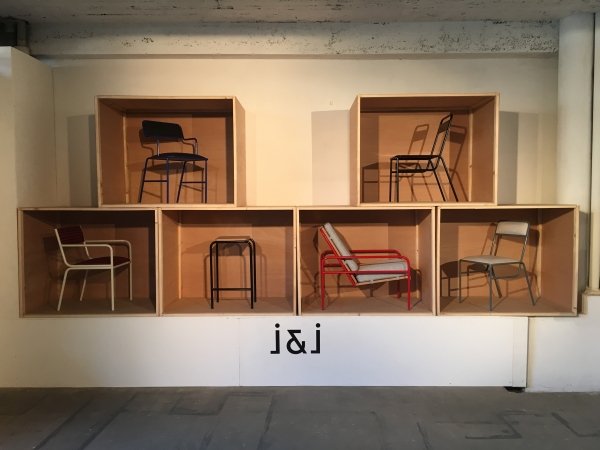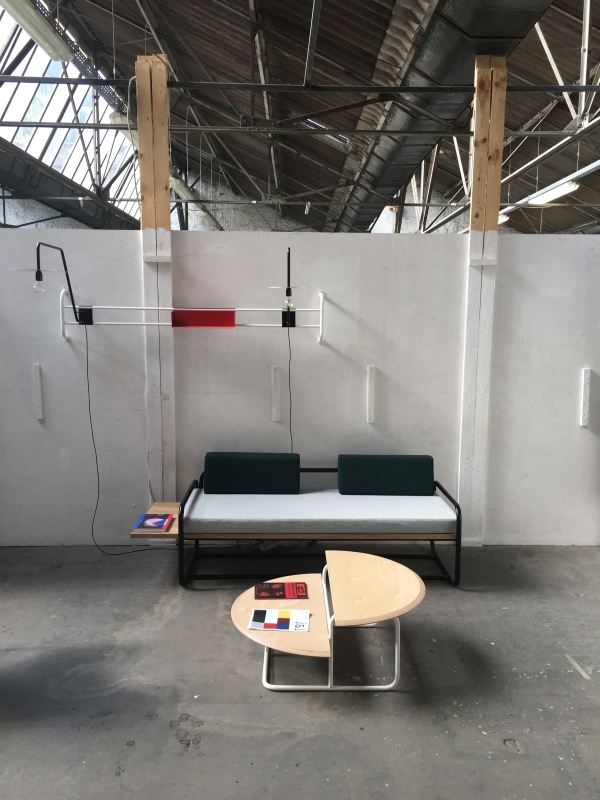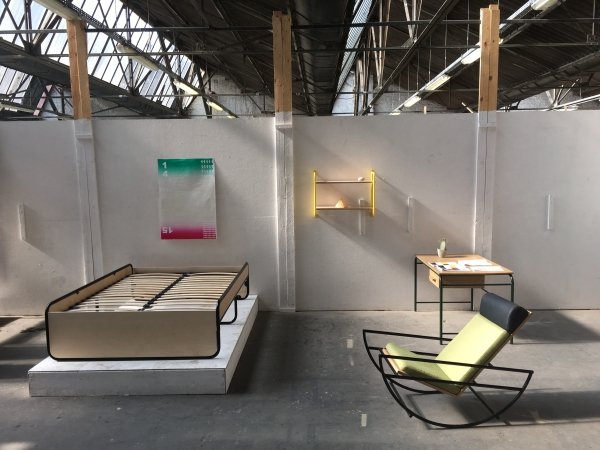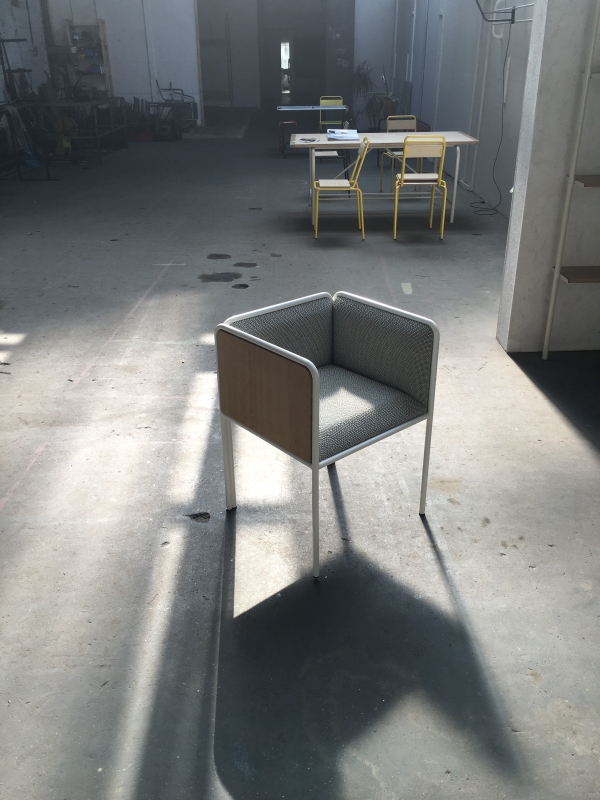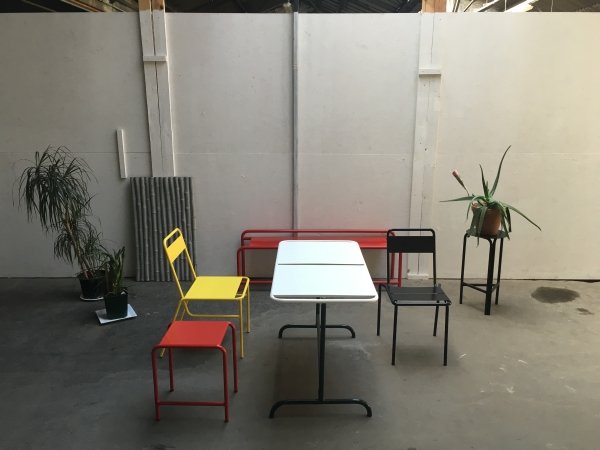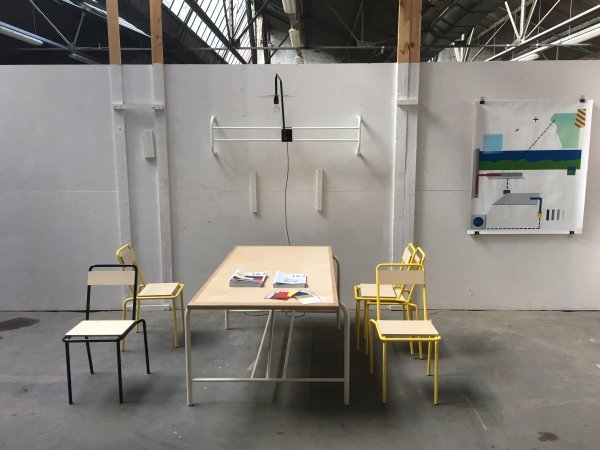Established in Brussels in 2011 by the French born, Belgian based craftsmen Jean Angelats and Jonathan Renou, Ateliers J&J released their inaugural collection in 2013. Presenting a range of domestic furnishing items crafted from bent tubular steel and solid wood Ateliers J&J's Collection 01 did nothing particularly innovative - and did it with a self-assured grace and composure that raised it far above the average and reminded us all just how enriching honestly conceived, well-proportioned, well-made furniture can be. In early summer 2015 Jonathan Renou departed, Jean Angelats decided to continue under the existing name and in October 2015 Ateliers J&J are releasing two new product lines: Collection 01 Evolution as an extension of Collection 01, and featuring in addition to numerous upholstered objects a truly outrageous rocking chair, and Collection 02, a range of completely new, demountable, objects including a sofa, a bed and a lamp.
Ahead of the launch of the new objects we met up with Jean Angelats at Ateliers J&J's new workshop in central Brussels to talk about the new collection, the origins of Ateliers J&J and contemporary furniture design, but began by asking how he personally arrived at furniture design.....
Jean Angelats: After working in various industries I spent several years working on building renovation projects, so involved in all aspects of building and construction work, and at some point decided it might be interesting to work at a smaller scale, not because I thought it would be easier but because I thought it would be more interesting.
smow blog: That means you have no formal training in furniture making and never studied design or anything related?
Jean Angelats: No, both Jonathan and I are completely self-taught, it was all learning by doing.
smow blog: You say you thought furniture making might be more interesting. When you established Ateliers J&J did you therefore have particular aims, or ideas of what you wanted to achieve?
Jean Angelats: At the beginning we just wanted to make furniture. Or at least to try. Being self-taught craftsman and having no other reference point we started with the materials, it seemed the natural place to begin and so it was the materials which formed the basis of our initial attempts. We worked with the materials, tried to understand the materials, we tested the materials and investigated what was possible; it was never a case of drawing something then constructing it, but always constructing first and then drawing.
smow blog: It is interesting you say that because we once wrote that it doesn't look like you're that interested in making furniture but rather shapes; but we now realise we may have drawn the wrong conclusion. We thought the form was the most important aspect, now we're thinking it might be the function...
Jean Angelats: ......the first thing is function. Always the function. Once we know what we want we start developing it. And although we have an idea of a form, because we work with tubular steel the material dictates to a large extent what is possible: tubular steel isn't the most flexible of materials, doesn't always do what you want it to, and so occasionally you have to say, "OK. It looks like this!". Which isn't automatically a bad thing, it just means the process isn't always under your control. With tubular steel one must always be prepared to compromise.
smow blog: And was this one of the things you had to learn, one of the reasons why it took two years before anything was publicly released?
Jean Angelats: The biggest problem at the beginning was that we had to find ways to finance the workshop, the materials, the machines, paying our own rent, and the like. And so it took a few months before we had the first few objects and realised that there were possibilities in what we were doing. Then after about a year we started to have enough regular income that at least the workshop costs were covered and then we could concentrate more on the collection. But it was hard, very hard even at times.
smow blog: The "we" in all this is important. The name Ateliers J&J was derived from J as in Jean and J as in Jonathan. Jonathan has now left, why? Creative differences?
Jean Angelats: No, no. Before the summer Jonathan decided that after all the work on the first collection that the time was right for a career change, or rather to return to the building and construction work he had been doing before. He decided that for him it was the correct decision and so he left the company and now I am alone, with my assistant, Thomas Heliot.
smow blog: And so is the new collection all your work or is there is still aspects of Jonathan in it?
Jean Angelats: The new collection is all my work, with help from Thomas. During the development we were talking the whole time, asking each other what do you think of this, of this, of that, trying new things and through this discussion the objects arose. However the final word and the final decision is always mine. There must always be one person who decides "yes" or "no".
smow blog: The new collection is technically two collections, the "proper" Collection 02 and Collection 01 Evolution. With the "Evolution" is that just to fill gaps in the portfolio or what is the thinking behind the objects?
Jean Angelats: When we made the first collection we didn't have much money, or much time and so the collection wasn't as expanded as it could have been. And now we have a little more freedom to evolve it in a few directions where we couldn't take it before. The rocking chair was the last object in the evolution from Collection One, then came the demountable collection.
smow blog: Which of course paves the way for the obvious question, why demountable?
Jean Angelats: In essence the plan was that demountable is more convenient for shipping.
smow blog: That simple?
Jean Angelats: That simple.
smow blog: Also that simple to realise?
Jean Angelats: What was very interesting with the demountable objects was always having to think that every object had to be demountable, and so can only have that what it absolutely needs, nothing unnecessary. You create your construction and that's it. Nothing extra. And this challenge of creating such reduced objects was a very interesting and stimulating process......
smow blog: .....but your work is so reduced! There was never that much there in the first place.....
Jean Angelats: Which is exactly what I want to achieve, to make the most simple furniture possible; when people look at our furniture they should understand the construction, follow how we have thought it through and so understand the work involved.
smow blog: Which again is what we've always liked about your work, this open, almost brutalist, construction principle where you can see how it is constructed. Which naturally poses the question, why the upholstery in the evolution collection, is that not too much of a divergence?
Jean Angelats: We wanted to offer something other than just the wooden seat, but even with the upholstery everything is visible and easy to understand, there is no mystery, no big secret, the owner can see how it has been made.
smow blog: We know you make all the wood and the metal components yourself, do also do the upholstery?
Jean Angelats: No, that is undertaken by Atelier Biermann, an upholstery workshop here in Brussels run by the brothers Adrien and Lionel Biermann.
smow blog: You stated at the beginning that you started as craftsmen, but now having completed two furniture collections and all the design thinking that has obviously involved, do you feel more like a designer?
Jean Angelats: To be honest, I don't think about such. I have a workshop and I make my furniture. Others must decide where I fit in. Today you have so much that is marketed as design and for me furniture design is a lot like music, it seems to be evolving a lot quicker than it used to, but not necessarily better. The music of the 60s was good, the 70s was good and then after the 1980s it all went a bit, well....
smow blog: ....nothing good since the 80s?
Jean Angelats: Nothing good since Italian disco!
smow blog: We like that, Ateliers J&J as the Italian disco of furniture design!
Jean Angelats: No, no, and there are naturally a lot of good things being produced today, but when you got to a fair such as Milan you realise just how commercial the industry is. A lot of people today design because they want to make money. And for me that is not enough. We should design because we need things, for me design is a very basic requirement; we need architecture for buildings and we need design for everything in the buildings. It's not complicated and it shouldn't be so expensive.
smow blog: You never studied design. Do you think that fact helps, does it perhaps allow you to maybe understand things differently than those designers who studied and so maybe help you find your own path?
Jean Angelats: I don't know, it's difficult to say. Thomas has just finished his masters in design at La Cambre, and for sure he knows things about design that I don't know. But I know my workshop, I know my materials, know what I want to make and I know people who can do the things I can't. The question is if I need to know more, or have to have more, in order to make my furniture?
smow blog: But are there other designers whose work you admire, other designers whose work you look to?
Jean Angelats: Jean Prouvé would be the major inspiration, when you see the work he was creating and when he was creating it, that is simply unbelievable. But then also the likes of Le Corbusier or Alvar Aalto. I know maybe ten designers and they are all old, so all before Italian disco!
smow blog: Moving to the future, do you plan to continue to develop the Ateliers J&J portfolio yourself, or can you imagine, for example, working with external designers?
Jean Angelats: I would really like to work with other designers, especially younger designers. I think there is a new generation coming through who are more interested in what they make than simply making money. And in addition I think that the new generation want to work more with materials and less with computer modelling and far removed from the workshop. And so yes if I can find young designers to work with then definitely.
smow blog: But will you be staying with tubular steel, or can we expect the next collection to be in a new material?
Jean Angelats: Other materials are always possible, but the first priority is new machines and new production methods so that we can produce the current objects more efficiently and at more affordable prices.
smow blog: And we presume that will then be here in Brussels?
Jean Angelats: Initially yes, however I may eventually move to Paris, not least because while although at the moment there are a lot of designers in Germany, Belgium or Holland, there aren't that many in France. OK, yes, there are the big ones, but they have a sort of monopoly, and so I think it would be very interesting to see what is possible in France.
smow blog: But still furniture, or.......?
Jean Angelats: I'm not so sure. In terms of furniture we can now offer all the essential items and so I think the next step is to create a little demountable house!
smow blog: We're laughing, but sense you're being serious...
Jean Angelats: Definitely! I think it is time to make such an object, something simple, not too expensive, maybe 25 or 30 square metres, but at the moment it is only an idea.
smow blog: And one we're already thoroughly looking forward to viewing........
More details on Ateliers J&J and their work can be found at http://ateliersjetj.com
We still haven’t seen all the new works and will therefore reserve our judgement until we have, here however a few photos by and courtesy of Ateliers J&J from the current exhibition.
